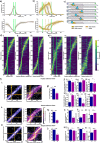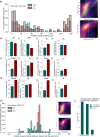This is a preprint.
Navigating uncertainty: reward location variability induces reorganization of hippocampal spatial representations
- PMID: 39829917
- PMCID: PMC11741294
- DOI: 10.1101/2025.01.06.631465
Navigating uncertainty: reward location variability induces reorganization of hippocampal spatial representations
Abstract
Navigating uncertainty is crucial for survival, with the location and availability of reward varying in different and unsignalled ways. Hippocampal place cell populations over-represent salient locations in an animal's environment, including those associated with rewards; however, how the spatial uncertainties impact the cognitive map is unclear. We report a virtual spatial navigation task designed to test the impact of different levels and types of uncertainty about reward on place cell populations. When the reward location changed on a trial-by-trial basis, inducing expected uncertainty, a greater proportion of place cells followed along, and the reward and the track end became anchors of a warped spatial metric. When the reward location then unexpectedly moved, the fraction of reward place cells that followed was greater when starting from a state of expected, compared to low, uncertainty. Overall, we show that different forms of potentially interacting uncertainty generate remapping in parallel, task-relevant, reference frames.
Keywords: expected uncertainty; hippocampus; remapping; reward place cells; unexpected uncertainty.
Conflict of interest statement
Conflict of interest/Competing interests The authors declare no conflict of interest.
Figures





References
-
- Aoki Y, Igata H, Ikegaya Y, et al. (2019) The integration of goal-directed signals onto spatial maps of hippocampal place cells. Cell reports 27(5):1516–1527 - PubMed
-
- Behrens TE, Woolrich MW, Walton ME, et al. (2007) Learning the value of information in an uncertain world. Nature neuroscience 10(9):1214–1221 - PubMed
-
- Best PJ, White AM, Minai A (2001) Spatial processing in the brain: the activity of hippocampal place cells. Annual review of neuroscience 24(1):459–486 - PubMed
Publication types
Grants and funding
LinkOut - more resources
Full Text Sources
